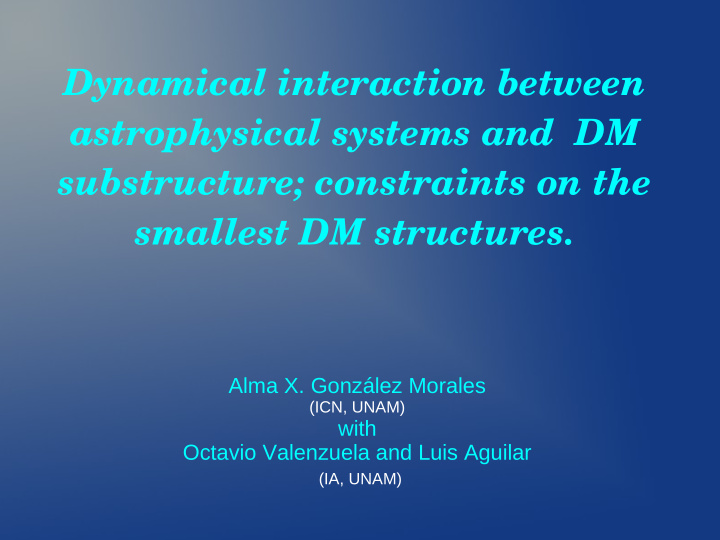



Dynamical interaction between astrophysical systems and DM substructure; constraints on the smallest DM structures. Alma X. González Morales (ICN, UNAM) with Octavio Valenzuela and Luis Aguilar (IA, UNAM)
Motivation: Subsolar mass objects are the first to form in a CMD Universe... To restrict its mass and abundance has important consequences to the identification of the dark matter particle because: (a) Different candidates predicts particular Cut-off in the mass power spectrum, i.e. a mass (size) limit on the smallest structure formed, depending on the particle model. (b) Its presence in the Galactic halo modifies the density and momentum phase space, having important implications for direct and indirect dark matter detection experiments.
But... There are no definitive observational constraints for mass power spectrum at the subgalactic scales Mass of the smallest structure DM candidate (M ʘ ) Neutralino ~ 10 -4 – 10 -6 (earth) Axion ~ 10 -15 (WDM) ~ 10 7 (8)
But... There are no definitive observational constraints for mass power spectrum at the subgalactic scales Related with the old missing satellite problem Mass of the smallest structure DM candidate (M ʘ ) Neutralino ~ 10 -4 – 10 -6 (earth) Axion ~ 10 -15 (WDM) ~ 10 7 (8)
Tidal interactions and violent relaxation mechanisms could dissolve the small halos leading to dark streams instead . N-body simulations are so useful to study the structure evolution, but don't reach the smallest scales (yet)... Zemp et. al. 2008 Remark They are DM only and one have to extrapolate down over several orders of magnitude...
Some options to restrict the smallest scales of the PS ● Fluctuations in gravitational lensing fluxes, image position, etc... (Keeton et al., Moustakas et.al, others...) ● Future observations of the HI-21 cm at high redshift (LOFAR,SKA... SCI-HI) *Sonda Cosmologica de la Isla Guadalupe para la Deteccion de HI a Alto Corrimiento al Rojo
SCI-HI* is an experiment to detect the HI global signal in Mexican radio quiet zones (ask about later...) *Sonda Cosmologica de la Isla Guadalupe para la Deteccion de HI a Alto Corrimiento al Rojo
Some options to restrict the smallest scales of the PS ● Fluctuations in gravitational lensing observables (Keeton et al., Moustakas et.al, others...) ● Future observations of the HI-21 cm at high redshift (LOFAR,SKA) ● Detection of ultra faint galaxies with GAIA (future) ● From the interaction of astrophysical systems with dark microhalos (Peñarrubia 2010, Schneider 2009)... *Sonda Cosmologica de la Isla Guadalupe para la Deteccion de HI a Alto Corrimiento al Rojo
Many works about the evolution of small structures due to their tidal interactions with Stars... … but what is the effect on the system bound to these stars? Fig. from Schneider et.al 2009 Zhao et. al.2005
What is the dynamic effect on the Solar system orbits? The SS has been widely used to test gravity theories, due to high precision determination of orbital elements. We perform Montecarlo experiments to estimate the energy perturbation over a SS orbit due to multiple encounters with dark micro-halos, and streams object, e.g. Neptune's and Earth-Moon orbit.
Astrophysical Tidal Interaction (Binney & Tremaine) with Subhalos Energy rate in the impulsive and U(b/rh) is a function that distant tide approximation depends on the density profile of subhalos. It approaches to 1 for large impact parameters The impact parameter ”b” follows a nearest-neighborhood distribution. The velocity of the encounter Depend on the numerical density of ”V” follows a Maxwell- subhalos, given by the Boltzmann distribution local DM density, the mass of the centered ~ 200 km/s. subhalos and the substructure fraction.
Astrophysical Tidal Interaction with Streams (our work) Energy rate in the impulsive and tidal approximation Linear density T, B, C, D are functions of the orientation with respect to the ecliptic plane and of the structure of the stream (cross section) Note is b 2 not b 4 As for subhalos Θ is the direction of movement of the stream...
● energy perturbation over Neptune's orbit due to one single encounter λ str= 10 -3 Msun/AU V0= 200 km/s Multiple encounters Probability distribution of the energy perturbation due to multiple encounters
Cumulative Effect of multiple encounters Results for the Neptune orbit due to subhalos (left) and streams (right). Canonical value of DM local density Uncertainty in the semi-major axis (E. V. Pitjeva and N.P. Pitjev 2012, I. B. Khriplovich and E. V. Pitjeva, 2009)
Cumulative Effect of multiple encounters Results for the Earth-Moon System due to subhalos (left) and streams (right). Uncertainty in the semi-major axis (APOLLO- LLR; J. G. Williams, S. G. Turyshev, and D. H. Boggs 2009)
Earth-Moon exclusion regions for substructure fraction and linear density of streams Simple approach, by computing the velocity dispersion of the initial subhalo, and assuming they have been under linear disruption for a Hubble time.
Final Remarks ● The dynamics of some astrophysical systems can be so sensitive that can be used to set constraints to the power spectrum cut-off. ● This avenue can be applied to binary stars, globular clusters and even extra-solar planets to test the distribution of DM substructure and try to constrain the PS. ● There can be a lot of dark substructure in the solar neighborhood and still being compatible with the Solar System dynamics. Direct and indirect detection experiments should take this into account; the spatial distribution and the fact that micro- halos and streams are kinematically colder than the soft component. ● Results are degenerate with the local density value and the substructure fraction, independent measurements of those will help. This avenue is totally independent of N-body simulations and very simple assumptions are done, the perturbed model can be as detailed as wanted though.
The case of wide binaries in the satellites of the Milky way.
Recommend
More recommend